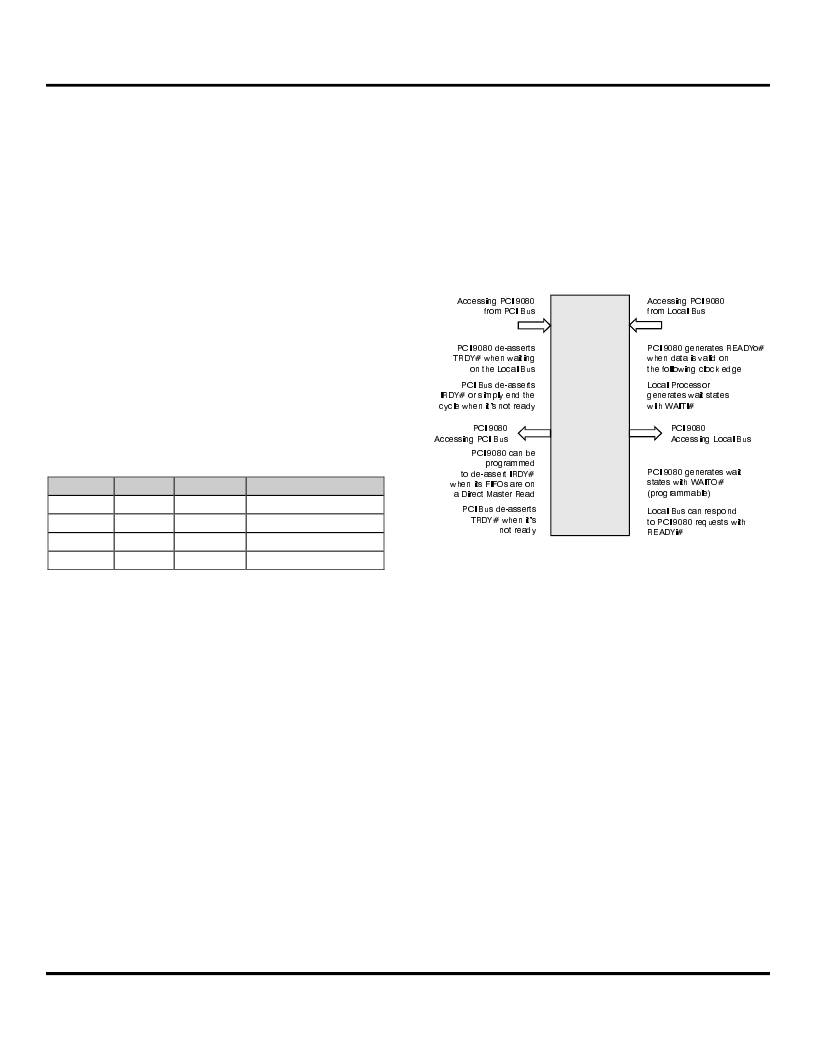- 您現(xiàn)在的位置:買賣IC網(wǎng) > PDF目錄367822 > PCI9060 (Electronic Theatre Controls, Inc.) 12O COMPATIBLE PCI BUS MASTER INTERFACE CHIP FOR ADAPTERS AND EMBEDDED SYSTEMS PDF資料下載
參數(shù)資料
| 型號: | PCI9060 |
| 廠商: | Electronic Theatre Controls, Inc. |
| 英文描述: | 12O COMPATIBLE PCI BUS MASTER INTERFACE CHIP FOR ADAPTERS AND EMBEDDED SYSTEMS |
| 中文描述: | 12O兼容的PCI總線主控接口芯片的適配器和嵌入式系統(tǒng) |
| 文件頁數(shù): | 16/192頁 |
| 文件大小: | 1551K |
| 代理商: | PCI9060 |
第1頁第2頁第3頁第4頁第5頁第6頁第7頁第8頁第9頁第10頁第11頁第12頁第13頁第14頁第15頁當(dāng)前第16頁第17頁第18頁第19頁第20頁第21頁第22頁第23頁第24頁第25頁第26頁第27頁第28頁第29頁第30頁第31頁第32頁第33頁第34頁第35頁第36頁第37頁第38頁第39頁第40頁第41頁第42頁第43頁第44頁第45頁第46頁第47頁第48頁第49頁第50頁第51頁第52頁第53頁第54頁第55頁第56頁第57頁第58頁第59頁第60頁第61頁第62頁第63頁第64頁第65頁第66頁第67頁第68頁第69頁第70頁第71頁第72頁第73頁第74頁第75頁第76頁第77頁第78頁第79頁第80頁第81頁第82頁第83頁第84頁第85頁第86頁第87頁第88頁第89頁第90頁第91頁第92頁第93頁第94頁第95頁第96頁第97頁第98頁第99頁第100頁第101頁第102頁第103頁第104頁第105頁第106頁第107頁第108頁第109頁第110頁第111頁第112頁第113頁第114頁第115頁第116頁第117頁第118頁第119頁第120頁第121頁第122頁第123頁第124頁第125頁第126頁第127頁第128頁第129頁第130頁第131頁第132頁第133頁第134頁第135頁第136頁第137頁第138頁第139頁第140頁第141頁第142頁第143頁第144頁第145頁第146頁第147頁第148頁第149頁第150頁第151頁第152頁第153頁第154頁第155頁第156頁第157頁第158頁第159頁第160頁第161頁第162頁第163頁第164頁第165頁第166頁第167頁第168頁第169頁第170頁第171頁第172頁第173頁第174頁第175頁第176頁第177頁第178頁第179頁第180頁第181頁第182頁第183頁第184頁第185頁第186頁第187頁第188頁第189頁第190頁第191頁第192頁

SECTION 2
PCI 9080
BUS OPERATION
PLX Technology, Inc., 1997
Page 7
Version 1.02
REQ# for a minimum of two PCI clocks between bus
master ownership that includes a target disconnect.
The Direct Master Write Delay bits (bits [15:14]) of the
DMPBAM
Register
(PCI:28h)(LOC:A8h)
programmed to delay the PCI 9080’s assertion of the
PCI REQ# signal during a Direct Master write cycle. This
register can be programmed to wait 0, 4, 8, or 16 PCI
bus clocks after the PCI 9080 has received its first write
data from the local master and is ready to begin the PCI
write transaction. This feature is useful in applications
where the local master is bursting and the local bus
clock is slower than the PCI bus clock. This allows write
data to accumulate in the PCI 9080’s Direct Master Write
FIFO, which provides for better PCI bus utilization.
can
be
2.2 LOCAL BUS CYCLES
PCI 9080 connects a PCI host bus to several local
processor bus types, as listed in Table 2-6. It operates in
one of three modes, selected through mode pins 9 and
10, corresponding to three bus types—C, J, and S.
Table 2-6. Local Processor Bus Types
Bit 9
Bit 10
Mode
Bus Type
0
0
C
32-bit nonmultiplexed
0
1
J
32-bit multiplexed
1
0
S
16-bit multiplexed
1
1
Reserved
—
2.2.1 Local Bus Arbitration
When PCI 9080 owns the local bus, both its LHOLD
output and LHOLDA input are asserted. When PCI 9080
samples BREQ asserted during a DMA transfer or
Direct Slave write transfer, it gives up the local bus
within two Lword transfers by de-asserting LHOLD and
floating its local bus outputs if BREQ is gated or
disabled, or if gating is enabled and the Local Bus
Latency Timer expires. The Local Arbiter can now grant
the local bus to another local master. After PCI 9080
samples that its LHOLDA is de-asserted and its local
pause timer is zero, it re-asserts LHOLD to request the
local bus. When the PCI 9080 receives LHOLDA, it
drives the bus and continues from where it left off.
2.2.2 Local Bus Direct Master
Local bus cycles can be continuous single or burst
cycles (programmable by way of the PCI 9080 internal
registers). As a local bus target, PCI 9080 allows access
to PCI 9080 internal registers and PCI bus.
In C and J modes, local bus direct master accesses to
the PCI 9080 must be for a 32 bit nonpipelined bus. In S
mode, local bus direct master accesses to the PCI 9080
must be for a 16 bit nonpipelined bus.
2.2.3 Local Bus Direct Slave
PCI Bus Master read/write to local bus (PCI 9080 is a
PCI bus target and local bus master).
2.2.3.1 Ready/Wait State Control
!
"!#
#! $ #
%
"
&&'
(
$
#
!
)
*!
!! !+
!
,
!
,'
-"%!.
! "
/
)
Figure 2-1. Wait States
If READYi# input is disabled, external READYi# input
has no effect on wait states for a local access. Wait
states between data cycles are generated internally by a
wait state counter. Wait state counter is initialized with its
configuration register value at the start of each data
access.
If READYi# is enabled, READYi# has no effect until the
wait state counter is 0. READYi# then controls the
number of additional wait states.
BTERM# input is not sampled until the wait state counter
is 0. BTERM# overrides READYi# when BTERM# is
asserted.
2.2.3.1.1 Wait State—Local Side
With Direct Master mode and accessing PCI 9080
registers (PCI 9080 local as slave):
PCI 9080 generates wait states with READYo#
Local processor generates wait states with WAITI#
相關(guān)PDF資料 |
PDF描述 |
|---|---|
| PCI9080 | 12O COMPATIBLE PCI BUS MASTER INTERFACE CHIP FOR ADAPTERS AND EMBEDDED SYSTEMS |
| PCI9060ES | 12O COMPATIBLE PCI BUS MASTER INTERFACE CHIP FOR ADAPTERS AND EMBEDDED SYSTEMS |
| PCI9060SD | 12O COMPATIBLE PCI BUS MASTER INTERFACE CHIP FOR ADAPTERS AND EMBEDDED SYSTEMS |
| PCI950PT | PC Card Support |
| PCI9656-AC66BI | Controller Miscellaneous - Datasheet Reference |
相關(guān)代理商/技術(shù)參數(shù) |
參數(shù)描述 |
|---|---|
| PCI90603A | 制造商:PLX Technology 功能描述: |
| PCI9060-3A | 制造商:PLX Technology 功能描述: |
| PCI9060-3AF | 功能描述:數(shù)字總線開關(guān) IC PCI Bus Interface RoHS:否 制造商:Texas Instruments 開關(guān)數(shù)量:24 傳播延遲時間:0.25 ns 最大工作溫度:+ 85 C 最小工作溫度:- 40 C 封裝 / 箱體:TSSOP-56 封裝:Reel |
| PCI9060ES | 制造商:未知廠家 制造商全稱:未知廠家 功能描述:12O COMPATIBLE PCI BUS MASTER INTERFACE CHIP FOR ADAPTERS AND EMBEDDED SYSTEMS |
| PCI9060ESF | 功能描述:數(shù)字總線開關(guān) IC PCI Bus Interface RoHS:否 制造商:Texas Instruments 開關(guān)數(shù)量:24 傳播延遲時間:0.25 ns 最大工作溫度:+ 85 C 最小工作溫度:- 40 C 封裝 / 箱體:TSSOP-56 封裝:Reel |
發(fā)布緊急采購,3分鐘左右您將得到回復(fù)。